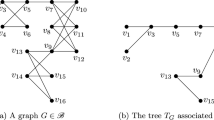Abstract
In this paper, we investigate the Laplacian, i.e., the normalized Laplacian tensor of a \(k\)-uniform hypergraph. We show that the real parts of all the eigenvalues of the Laplacian are in the interval \([0,2]\), and the real part is zero (respectively two) if and only if the eigenvalue is zero (respectively two). All the H\(^+\)-eigenvalues of the Laplacian and all the smallest H\(^+\)-eigenvalues of its sub-tensors are characterized through the spectral radii of some nonnegative tensors. All the H\(^+\)-eigenvalues of the Laplacian that are less than one are completely characterized by the spectral components of the hypergraph and vice verse. The smallest H-eigenvalue, which is also an H\(^+\)-eigenvalue, of the Laplacian is zero. When \(k\) is even, necessary and sufficient conditions for the largest H-eigenvalue of the Laplacian being two are given. If \(k\) is odd, then its largest H-eigenvalue is always strictly less than two. The largest H\(^+\)-eigenvalue of the Laplacian for a hypergraph having at least one edge is one; and its nonnegative eigenvectors are in one to one correspondence with the flower hearts of the hypergraph. The second smallest H\(^+\)-eigenvalue of the Laplacian is positive if and only if the hypergraph is connected. The number of connected components of a hypergraph is determined by the H\(^+\)-geometric multiplicity of the zero H\(^+\)-eigenvalue of the Lapalacian.
Similar content being viewed by others
Notes
The matrix-tensor product is in the sense of (Qi 2005, p. 1321): \(\mathcal{L }=(l_{i_1\ldots i_k}):=P^k\cdot (\mathcal D -\mathcal{A })\) is a \(k\)-th order \(n\)-dimensional tensor with its entries being \(l_{i_1\ldots i_k}:\!=\!\sum _{j_s\in [n],\;s\in [k]}p_{i_1j_1}\cdots p_{i_kj_k}(d_{j_1\ldots j_k}-a_{j_1\ldots j_k})\).
By the discussion on (Qi 2005, p. 1315) they must appear in conjugate complex pairs. They are called N-eigenvalues in that paper.
References
Berge C (1973) Hypergraphs. combinatorics of finite sets, 3rd edn. North-Holland, Amsterdam.
Bertsekas DP (1999) Nonlinear programming, 2nd edn. Athena Scientific.
Brouwer AE, Haemers WH (2011) Spectra of graphs. Springer, New York
Chang KC, Pearson K, Zhang T (2008) Perron-Frobenius theorem for nonnegative tensors. Commun Math Sci 6:507–520
Chang KC, Pearson K, Zhang T (2011) Primitivity, the convergence of the NQZ method, and the largest eigenvalue for nonnegative tensors. SIAM J Matrix Anal Appl 32:806–819
Chung FRK (1997) Spectral graph theory. Am Math Soc.
Cooper J, Dutle A (2012) Spectra of uniform hypergraphs. Linear Algebra Appl 436:3268–3292
Cox D, Little J, O’Shea D (1998) Using algebraic geometry. Springer, New York
Cox D, Little J, O’Shea D (2006) Ideals, varieties, and algorithms: an introduction to computational algebraic geometry and commutative algebra. Springer, New York
Fidalgo C, Kovacec A (2011) Positive semidefinite diagonal minus tail forms are sums of squares. Mathematische Zeitschrift 269:629–645
Friedland S, Gaubert S, Han L (2013) Perron-Frobenius theorem for nonnegative multilinear forms and extensions. Linear Algebra Appl 438:738–749
Horn RA, Johnson CR (1985) Matrix analysis. Cambridge University Press, New York
Hu S, Qi L (2012a) Algebraic connectivity of an even uniform hypergraph. J Comb Optim 24:564–579
Hu S, Qi L (2012b) The E-eigenvectors of tensors. The Hong Kong Polytechnic University, Manuscript
Hu S, Huang ZH, Qi L (2011) Finding the spectral radius of a nonnegative tensor. arXiv:1111.2138v1.
Hu S, Li G, Qi L, Song Y (2012) Finding the maximum eigenvalue of essentially nonnegative symmetric tensors via sum of squares programming. University of New South Wales, Revised manuscript
Hu S, Huang ZH, Ling C, Qi L (2013) On determinants and eigenvalue theory of tensors. J Symb Comput 50:508–531
Lang S (2002) Algebra. Revised third edition, Springer, New York
Li G, Qi L, Yu G (2012) The Z-eigenvalues of a symmetric tensor and its application to spectral hypergraph theory. Numer, Linear Algebr (to appear)
Lim L-H (2005) Singular values and eigenvalues of tensors: a variational approach. In: Proceedings of the IEEE international workshop on computational advances in multi-sensor adaptive processing, CAMSAP ’05, vol 1, pp 129–132.
Lim L-H (2007) Foundations of numerical multilinear algebra: decomposition and approximation of tensors. PhD thesis, Standford University, USA.
Ng M, Qi L, Zhou G (2009) Finding the largest eigenvalue of a non-negative tensor. SIAM J Matrix Anal Appl 31:1090–1099
Pearson KJ, Zhang T (2012) On spectral hypergraph theory of the adjacency tensor. arXiv:1209.5614.
Qi L (2005) Eigenvalues of a real supersymmetric tensor. J Symb Comput 40:1302–1324
Qi L (2006) Rank and eigenvalues of a supersymmetric tensor, a multivariate homogeneous polynomial and an algebraic surface defined by them. J Symb Comput 41:1309–1327
Qi L (2007) Eigenvalues and invariants of tensors. J Math Anal Appl 325:1363–1377
Qi L (2012) H\(^+\)-eigenvalues of Laplcian tensor and signless Laplacians. The Hong Kong Polytechnic University, Manuscript
Qi L (2012) Symmetric nonnegative tensors and copositive tensors. arXiv:1211.5642v1.
Rota Bulò S (2009) A game-theoretic framework for similarity-based data clustering. PhD thesis, Università Ca’ Foscari di Venezia, Italy.
Rota Bulò S, Pelillo M (2009) A generalization of the Motzkin-Straus theorem to hypergraphs. Optim Lett 3:187–295
Xie J, Chang A (2012a) On the Z-eigenvalues of the signless Laplacian tensor for an even uniform hypergraph. Fuzhou University, Manuscript
Xie J, Chang A (2012b) On the Z-eigenvalues of the adjacency tensors for uniform hypergraphs. Fuzhou University, Manuscript
Xie J, Chang A (2013c) On the H-eigenvalues of the signless Laplacian tensor for an even uniform hypergraph. Front Math China 8:107–128
Yang Y, Yang Q (2010) Further results for Perron-Frobenius theorem for nonnegative tensors. SIAM J Matrix Anal Appl 31:2517–2530
Yang Q, Yang Y (2011) Further results for Perron-Frobenius theorem for nonnegative tensors II. SIAM J Matrix Anal Appl 32:1236–1250
Zhang L, Qi L, Zhou G (2012) M-tensors and the positive definiteness of a multivariate form. arXiv:1202.6431.
Acknowledgments
Liqun Qi was supported by the Hong Kong Research Grant Council (Grant No. PolyU 501909, 502510, 502111 and 501212).
Author information
Authors and Affiliations
Corresponding author
Rights and permissions
About this article
Cite this article
Hu, S., Qi, L. The Laplacian of a uniform hypergraph. J Comb Optim 29, 331–366 (2015). https://doi.org/10.1007/s10878-013-9596-x
Published:
Issue Date:
DOI: https://doi.org/10.1007/s10878-013-9596-x




